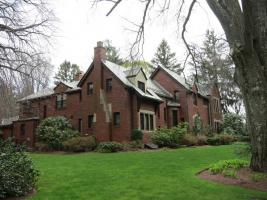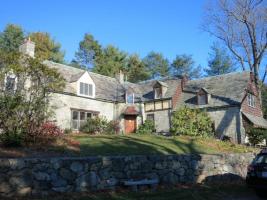Tudor Revival: 1920-1940
Tudor Revival: 1920-1940
Vying for popularity with the Colonial Revival in the early 20th century were a number of eclectic styles based loosely on English prototypes and designed for a more picturesque effect. The buildings lack the symmetry of the Colonial and typically display steeply-pitched gables with decorated vergeboards, half-timbering and diamond-paned windows.
Examples Found in Belmont:

Varaztad Kazanjian House, 1930 | 191 Clifton St.
191 Clifton Street is a good example of the Tudor Revival style, with a brick exterior with concrete and stucco trim. The main entrance is framed by a Tudor arch quoined surround and quoined contrasting masonry also frames several tripartite windows. Other details include wooden braces supporting the overhanging eaves below the stuccoed wall dormer, a rounded projection on the façade and the Gothic lantern over the entrance. In addition to the sets of casements, the variety of windows include multi-light casements with stone sills and long narrow windows.

Frank Barnard House, 1911 | 43 Village Hill Rd.
Constructed in 1936 the house at 43 Village Hill Road is of interest as an example of the work of architect Royal Barry Wills, master of the Cape Cod/Colonial Revival, in the English Revival mode. Displaying a stone exterior reminiscent of an English cottage, the dwelling incorporates stuccoed dormers, areas of applied half timbering, live edge wood weatherboards, diamondpaned casement windows, a slate roof and stone chimneys.


